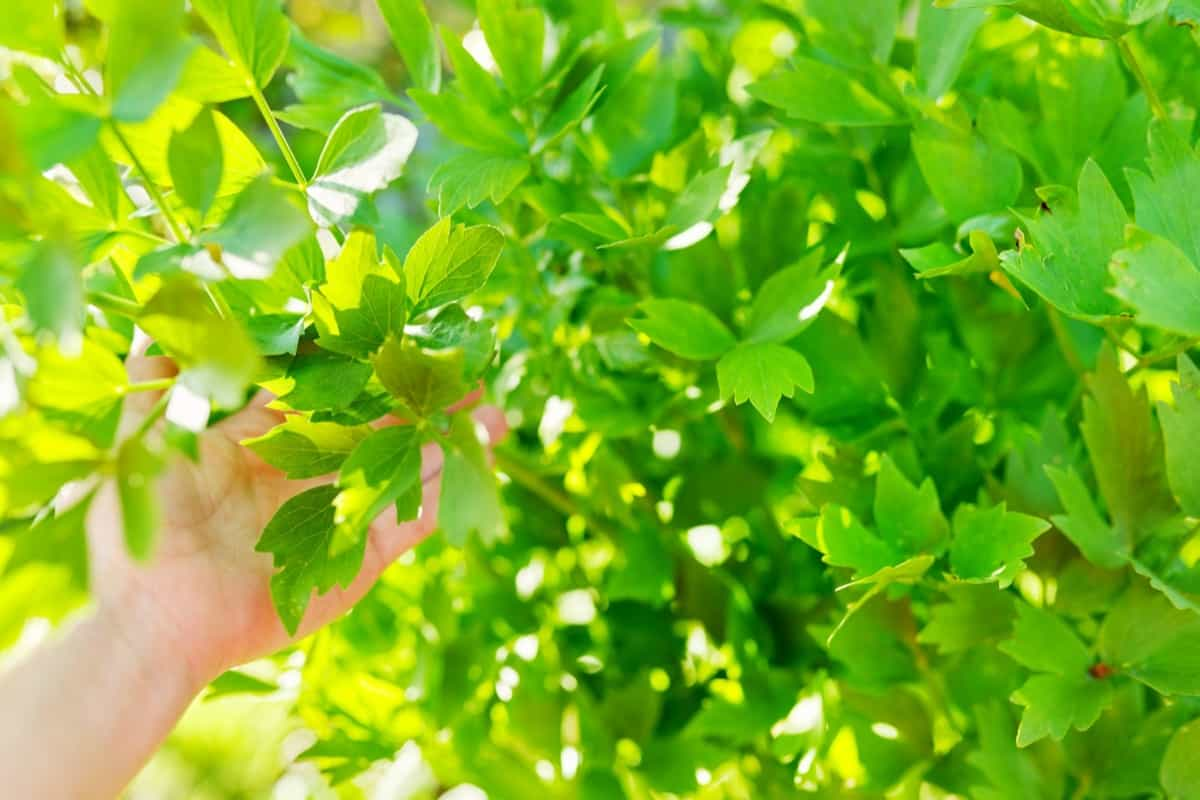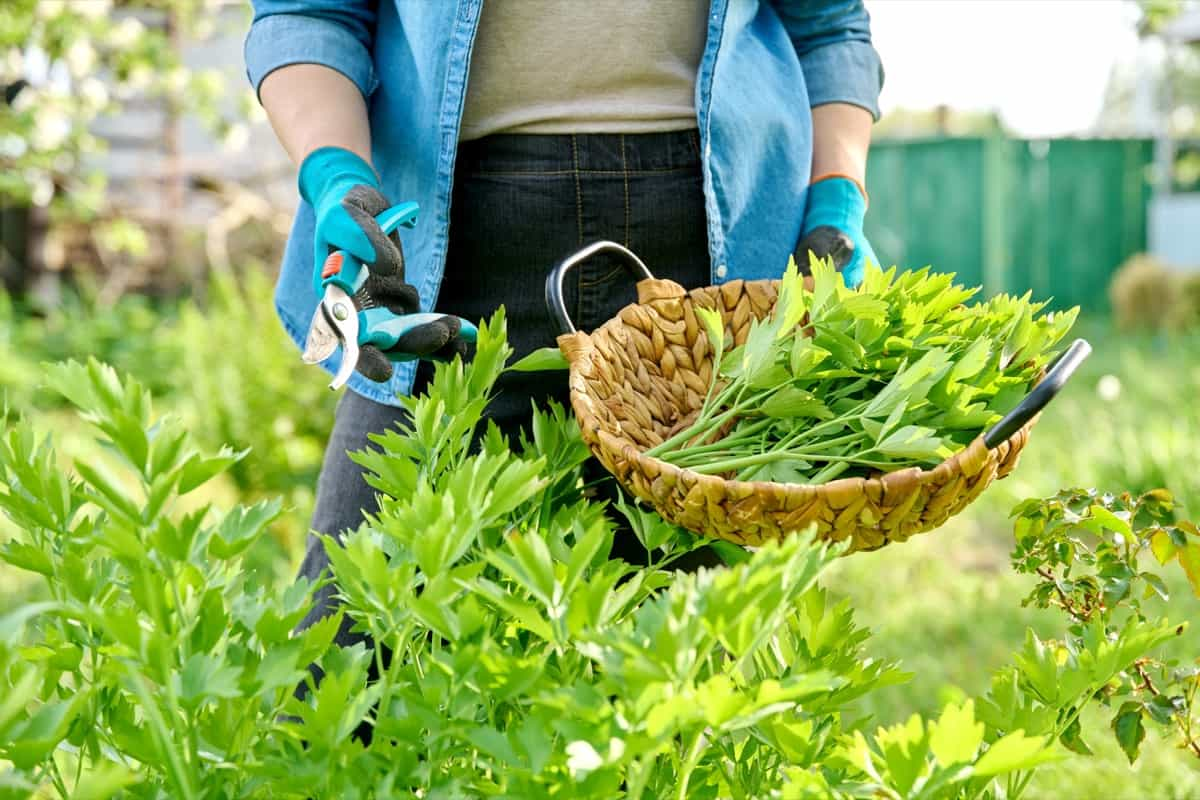Lovage, an herb of the parsley family (Apiaceae), is a powerhouse of flavor and fragrance. The greenish-yellow flowers of Lovage act as magnets for beneficial insects like bees and butterflies that help pollinate other plants in your garden. This perennial plant has been cultivated for centuries for its culinary and therapeutic properties, native to southern Europe and Western Asia.

How to Grow and Care for Organic Lovage
Organic Soil Preparation for Growing Lovage
Lovage thrives best in well-draining soil with a pH of 6.0 to 7.0. Start by testing the soil pH level using a home testing kit at a local agricultural extension office. If the pH falls outside the recommended range, you can adjust it by adding amendments like lime to raise the pH level or sulfur to lower it. Before planting Lovage, prepare the soil by removing weeds or debris and loosening it with a garden fork or tiller. This will promote good air circulation and root development.
Information about Growing Lovage
| Plant Name | Lovage |
| Perennial | (Zones 4-8) |
| Soil pH | 6.0 to 7.0 |
| Seed Life | 2 years |
| Germination | 10-21 days |
| Soil | Well-drained, rich, moist |
| Sunlight | Partial shade |
| Harvesting | 90 days |
Step-by-Step Guide to Growing Organic Lovage in Your Garden
Choose an Ideal Location – Lovage thrives in full sun but can tolerate partial shade. Choose a place in your garden that receives at least six hours of direct sunlight daily. Ensure the area has well-drained soil to prevent waterlogging.
Prepare the Soil – Before planting Lovage, the soil is loosened using a garden fork or tiller. Remove any weeds or debris and incorporate organic matter into the soil. This will improve drainage and provide essential nutrients for healthy growth.
Sow Lovage Seeds – Sow Lovage seeds directly into the prepared soil, around half an inch deep. Space the seeds about 18 to 24 inches apart as Lovage grows in clumps. Water gently after sowing to ensure good seed-to-soil contact.
Watering and Care – Water regularly, keeping the soil moist but not soggy. Avoid overwatering the Lovage plant, as this can lead to root rot. Mulch around the plants with organic material like straw to retain moisture and suppress weed growth.
Fertilizing – Feed your Lovage plants with organic fertilizer once every month during the growing season. A balanced nitrogen, phosphorus, and potassium formula promotes strong stems and lush foliage.
Pruning and Harvesting – Prune your Lovage plants regularly by removing any dead or yellow leaves from the base of the plant. This encourages new growth throughout the season. When harvesting, cut young stems from near ground level early in spring for culinary use. Remember never to remove more than one-third of foliage at a time so the plant remains healthy.
In case you missed it: How to Treat Brown Spots on Spider Plant: Causes, Fix With Natural Effective Home Remedies

Growing Organic Lovage from Seeds
- Firstly, choose high-quality organic Lovage seeds. Look for reputable seed suppliers that offer certified organic options.
- Before sowing the seeds, prepare the soil by removing any weeds or debris.
- Sow the Lovage seeds about half an inch deep outdoors and space them 18 to 24 inches apart. It’s important to note that Lovage tends to grow in clumps, so give each plant enough room to thrive.
- Water the newly planted seeds gently but thoroughly, ensuring the soil remains moist until germination occurs.
- As for fertilizing, use natural and organic options such as compost or well-rotted manure. Avoid using synthetic fertilizers that may harm both your plant and the environment.
- When harvesting Lovage leaves and stems, cut them close to their base using scissors or pruning shears.
How to Care for Organic Lovage Plants in Containers?
- Firstly, choose the right-sized container for your Lovage plant. It needs ample space for its deep root system to spread out.
- Next, provide your Lovage with well-draining soil. Mix equal parts of compost, potting soil, and perlite or vermiculite to create a light and airy growing medium.
- Watering is crucial when it comes to container gardening. Lovage prefers moist but not waterlogged soil.
- As for sunlight, Lovage enjoys full sun but can tolerate partial shade. Fertilize your Lovage every four weeks during the growing season with an organic liquid fertilizer diluted according to package instructions.
Watering and Fertilizing Organic Lovage: Dos and Don’ts
Dos
- Water consistently: Lovage plants prefer moist soil, so water them regularly, especially during dry periods.
- Provide deep watering: Ensure that the water reaches the root zone by watering deeply rather than just surface-level sprinkling.
- Mulch around the base: Apply a layer of organic mulch around the Lovage plant to help retain moisture and prevent weed growth.
- Use organic fertilizer: Opt for natural, slow-release fertilizers like compost or well-rotted manure to provide nutrients without synthetic chemicals.
Don’ts
- Overwater: Avoid overwatering as it can lead to root rot and other diseases. Then, allow the garden soil to dry out before watering the plant again.
- Use chemical fertilizers: Steer clear of synthetic fertilizers as they can harm beneficial organisms in the soil and disrupt ecological balance.
Organic Pest and Disease Control for Lovage Plants
Lovage plants are generally hardy and resistant to most pests and diseases. One effective method of organic pest control is companion planting. You can deter common pests such as aphids and whiteflies by growing Lovage alongside fennel, hyssop, and catmint. To further protect your Lovage plants naturally, consider using trap crops.
Planting extra Lovage plants near susceptible vegetables like tomatoes can help lure tomato hornworms away from the main crop. This safeguards your precious tomatoes and provides an additional food source for these caterpillars. Another important aspect of organic pest control is attracting beneficial insects to the garden. When it comes to disease prevention, proper care practices are essential. Avoid overwatering or allowing waterlogged conditions, leading to root rot or fungal infections.
Companion Planting with Organic Lovage for Increased Yields
- The best companion plants for Lovage are Fennel, Hyssop, and Catmint. It can be used as a trap crop to lure tomato hornworms away from tomatoes. The greenish-yellow color flowers attract beneficial insects to the garden.
- One great companion plant for Lovage is fennel. These two herbs share similar growing conditions, and their aromatic properties can repel pests such as aphids and slugs.
- Another excellent companion plant for Lovage is hyssop. Hyssop attracts beneficial insects like bees, butterflies, and ladybugs, which assist in pollination while also preying on harmful pests. This will enhance your garden’s beauty and promote a healthier ecosystem.
- Additionally, catmint is an ideal companion for Lovage because it attracts predatory insects that feed on common garden pests like aphids and spider mites. You can create a natural defense system against unwanted visitors by planting these two together.
In case you missed it: Natural Remedies for Yellowing Leaves: Treatment and Solutions

Harvesting and Preserving Organic Lovage Leaves and Stems
Harvesting Lovage is a simple process that can be done throughout the growing season. When it comes to harvesting leaves and stems, you have two options. You can pick individual leaves as needed or cut back the entire plant immediately. If you choose to harvest individual leaves, snip them off close to the base of the stem.
This method allows for a continuous supply of fresh Lovage throughout the season. For a more significant harvest, cutting back the whole plant is recommended. When doing so, leave about 2-3 inches of growth above ground level. This will allow your Lovage plant to regrow and continue producing flavorful foliage.
One popular preservation method is drying. Hang small bunches upside down in a ventilated area away from direct sunlight until dry. Once dried, store them in a container for long-term use. Another option is freezing Lovage leaves and stems. Wash them thoroughly before chopping them into desired sizes or blending them with olive oil before freezing them in ice cube trays for easy portioning later.
Conclusion
Lovage is a hardy perennial that can bring an explosion of flavor and fragrance to your dishes. It thrives in various soil types and tolerates sun and partial shade conditions. While container gardening with Lovage is possible, remember that these plants require adequate watering and fertilizing throughout their growth cycle.
- Feed Your Flock for Less: Top 10 Tips to Save on Chicken Feed
- Ultimate Guide to Ossabaw Island Hog: Breeding, Raising, Diet, and Care
- Hatching Answers: The Top 10 Reasons Your Chickens Aren’t Laying Eggs
- Eggs and Economics: Breaking Down the Cost of Raising Backyard Chickens
- Defend Your Greens: Proven Methods to Keep Iguanas Out of Your Garden
- Ultimate Guide to Cinnamon Queen Chicken: A Comprehensive Guide for Beginners
- Ultimate Guide to California Tan Chicken: Breeding, Raising, Diet, Egg-Production and Care
- Ultimate Guide to Marsh Daisy Chicken: Breeding, Raising, Diet, and Care
- 10 Types of Chicken Farming Businesses You Can Start for Profits